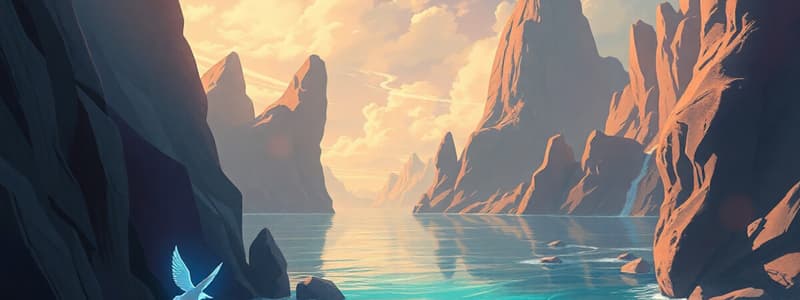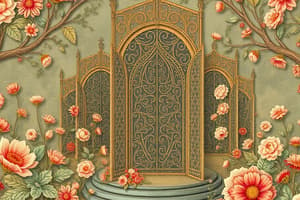Podcast
Questions and Answers
Which of the following is NOT considered a primary category of the arts?
Which of the following is NOT considered a primary category of the arts?
- Culinary Arts (correct)
- Performing Arts
- Visual Arts
- Literary Arts
Sculpture is a two-dimensional art form that involves applying pigments to a surface.
Sculpture is a two-dimensional art form that involves applying pigments to a surface.
False (B)
What art element refers to the lightness or darkness of a color or tone?
What art element refers to the lightness or darkness of a color or tone?
value
The art movement known as __________, which emerged in the late 19th century, focused on capturing fleeting moments and the effects of light.
The art movement known as __________, which emerged in the late 19th century, focused on capturing fleeting moments and the effects of light.
Match the following art movements with their approximate time periods:
Match the following art movements with their approximate time periods:
Which principle of art refers to the distribution of visual weight in a work of art?
Which principle of art refers to the distribution of visual weight in a work of art?
Formalism in art criticism focuses primarily on the social, cultural, and historical context of a work.
Formalism in art criticism focuses primarily on the social, cultural, and historical context of a work.
What is the term for art created by individuals outside the mainstream art world, often with mental health issues or disabilities?
What is the term for art created by individuals outside the mainstream art world, often with mental health issues or disabilities?
________ is the art of movement, often accompanied by music, to express emotions or tell a story.
________ is the art of movement, often accompanied by music, to express emotions or tell a story.
Match the following literary genres with their descriptions:
Match the following literary genres with their descriptions:
Which of the following is a characteristic of Baroque art?
Which of the following is a characteristic of Baroque art?
Collage involves creating three-dimensional art by carving materials.
Collage involves creating three-dimensional art by carving materials.
What is the term for the process of creating motion pictures?
What is the term for the process of creating motion pictures?
__________ art is created specifically for the internet and often addresses issues related to technology and society.
__________ art is created specifically for the internet and often addresses issues related to technology and society.
Match the art criticism approaches with their focus:
Match the art criticism approaches with their focus:
Which art form combines elements of theatre, visual arts, and other disciplines to create live events?
Which art form combines elements of theatre, visual arts, and other disciplines to create live events?
Rococo art is known for its dramatic and elaborate style.
Rococo art is known for its dramatic and elaborate style.
What is the term for the study of the development of art throughout time and across different cultures?
What is the term for the study of the development of art throughout time and across different cultures?
__________ art utilizes computer technology as an essential part of the creative or presentation process.
__________ art utilizes computer technology as an essential part of the creative or presentation process.
Match the following types of art with their general descriptions:
Match the following types of art with their general descriptions:
Flashcards
Arts
Arts
Human activities involving creative expression, conveying emotions, ideas, and cultural values through visual, performing, and literary forms.
Visual Arts
Visual Arts
Art forms that create primarily visual works, such as paintings, sculptures, photography, and printmaking.
Painting
Painting
Applying pigments to a surface to create an image, design, or decoration.
Sculpture
Sculpture
Signup and view all the flashcards
Performing Arts
Performing Arts
Signup and view all the flashcards
Theatre
Theatre
Signup and view all the flashcards
Dance
Dance
Signup and view all the flashcards
Literary Arts
Literary Arts
Signup and view all the flashcards
Poetry
Poetry
Signup and view all the flashcards
Elements of Art
Elements of Art
Signup and view all the flashcards
Line
Line
Signup and view all the flashcards
Shape
Shape
Signup and view all the flashcards
Form
Form
Signup and view all the flashcards
Principles of Art
Principles of Art
Signup and view all the flashcards
Balance
Balance
Signup and view all the flashcards
Contrast
Contrast
Signup and view all the flashcards
Emphasis
Emphasis
Signup and view all the flashcards
Art History
Art History
Signup and view all the flashcards
Art Criticism
Art Criticism
Signup and view all the flashcards
Digital Art
Digital Art
Signup and view all the flashcards
Study Notes
- Arts encompass a diverse range of human activities involving creative expression.
- They include visual arts, performing arts, and literary arts.
- Arts provide a medium for conveying emotions, ideas, and cultural values.
- They can serve aesthetic, symbolic, ritualistic, or functional purposes.
Visual Arts
- Visual arts are art forms that create works that are primarily visual in nature.
- Examples include painting, sculpture, photography, and printmaking.
- Painting involves applying pigments to a surface to create an image, design, or decoration.
- Sculpture is the creation of three-dimensional art, typically by carving, modeling, or assembling materials.
- Photography is the art of capturing images using light and a camera.
- Printmaking involves creating multiple identical or varied artworks from a single design.
- Other forms include drawing, collage, digital art, and filmmaking.
- Drawing is a fundamental visual art form involving mark-making on a surface.
- Collage involves assembling different materials onto a surface to create a new image.
- Digital art uses computer technology to create images and designs.
- Filmmaking is the process of creating motion pictures.
Performing Arts
- Performing arts are art forms that are performed in front of an audience.
- These include theatre, dance, music, and performance art.
- Theatre involves dramatic performances presented on stage.
- Dance is the art of movement, often accompanied by music, to express emotions or tell a story.
- Music is an art form that uses sound and rhythm to create compositions.
- Performance art combines elements of theatre, visual arts, and other disciplines to create live events.
- Opera is a form of theatre that combines music, drama, and singing.
- Circus arts include acrobatics, juggling, and clowning.
- Spoken word is a performance art based on the oral tradition of poetry and storytelling.
Literary Arts
- Literary arts involve written works that are valued for their aesthetic and intellectual qualities.
- Literature includes genres such as poetry, prose (novels, short stories), and drama (plays).
- Poetry is a form of literary art that uses aesthetic and rhythmic qualities of language.
- Prose includes novels and short stories, which tell fictional or non-fictional narratives.
- Drama encompasses plays written for theatrical performance.
- Essays are non-fiction compositions that explore a particular subject or argument.
- Screenwriting involves writing scripts for films or television.
- Creative non-fiction blends factual reporting with literary techniques.
Elements and Principles of Art
- The elements of art are the basic building blocks used to create a work of art.
- These include line, shape, form, color, value, texture, and space.
- Line is a mark made on a surface, which can be straight, curved, or implied.
- Shape is a two-dimensional area with a defined boundary.
- Form is a three-dimensional object with volume and mass.
- Color is the visual perception of light reflecting off a surface.
- Value refers to the lightness or darkness of a color or tone.
- Texture is the surface quality of an object, both real and implied.
- Space refers to the area around and within objects in a work of art.
- The principles of art are guidelines that artists use to organize the elements of art.
- These include balance, contrast, emphasis, pattern, rhythm, unity, and proportion.
- Balance refers to the distribution of visual weight in a work of art.
- Contrast is the arrangement of opposite elements in a composition.
- Emphasis is the focal point of a work of art that attracts the viewer's attention.
- Pattern is the repetition of elements in a planned or random way.
- Rhythm is the visual tempo or beat created by repeating elements.
- Unity is the sense of harmony and coherence in a work of art.
- Proportion refers to the relative size and scale of elements in a design.
Art History
- Art history is the study of the development of art throughout time and across different cultures.
- It examines the social, cultural, and historical contexts of artworks.
- Prehistoric art includes cave paintings, sculptures, and other artifacts from ancient cultures.
- Ancient art encompasses the art of civilizations such as Egypt, Greece, and Rome.
- Medieval art includes Byzantine, Romanesque, and Gothic art.
- Renaissance art flourished in Europe from the 14th to the 16th centuries, marked by a revival of classical art and culture.
- Baroque art (17th century) is characterized by dramatic, elaborate, and ornate style.
- Rococo art (18th century) is known for its ornate, delicate, and playful aesthetic.
- Neoclassical art (18th-19th centuries) drew inspiration from classical Greek and Roman art.
- Romantic art (late 18th-19th centuries) emphasized emotion, individualism, and the sublime.
- Realism (19th century) aimed to depict subjects as they appear in everyday life.
- Impressionism (late 19th century) focused on capturing fleeting moments and the effects of light.
- Post-Impressionism (late 19th century) was a reaction against Impressionism, exploring subjective expression and symbolic meanings.
- Modern art (late 19th-20th centuries) includes various styles such as Cubism, Surrealism, and Abstract Expressionism.
- Contemporary art (late 20th-21st centuries) reflects current cultural trends and often challenges traditional art forms.
Art Criticism and Theory
- Art criticism involves evaluating and interpreting works of art.
- It often considers the artwork's formal qualities, context, and meaning.
- Formalism focuses on the visual elements and design principles of art.
- Contextualism examines the social, cultural, and historical context of art.
- Semiotics analyzes the signs and symbols in art to understand its meanings.
- Psychoanalysis applies psychological theories to interpret art.
- Marxism views art as a reflection of social and economic power structures.
- Feminism examines the role of gender in art and art history.
- Post-structuralism questions traditional notions of meaning and interpretation.
Art and Culture
- Art reflects and shapes culture by expressing values, beliefs, and ideas.
- It can serve as a form of social commentary and political activism.
- Art plays a role in preserving cultural heritage and traditions.
- Patronage and funding influence the production and distribution of art.
- Art markets and galleries facilitate the buying and selling of art.
- Museums and institutions collect, preserve, and exhibit art for public enjoyment and education.
- Art education fosters creativity, critical thinking, and cultural awareness.
- Indigenous art is art created by native or aboriginal peoples.
- Folk art is art created by people who are self-taught or have limited formal training.
- Outsider art is art created by individuals outside the mainstream art world, often with mental health issues or disabilities.
Digital Art and New Media
- Digital art utilizes computer technology as an essential part of the creative or presentation process.
- Examples include digital painting, digital photography, and computer-generated imagery (CGI).
- New media art encompasses artworks created with technologies such as the internet, virtual reality, and interactive installations.
- Video art uses video as a primary medium for artistic expression.
- Interactive art allows the audience to participate in the artwork.
- Generative art uses algorithms and computer programs to create autonomous artworks.
- Net art is created specifically for the internet and often addresses issues related to technology and society.
Studying That Suits You
Use AI to generate personalized quizzes and flashcards to suit your learning preferences.




